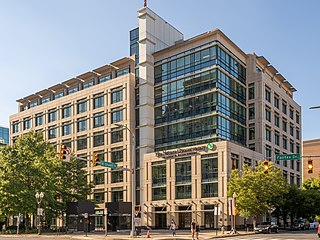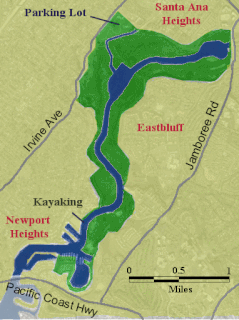
The Nature Conservancy (TNC) is a global environmental organization, headquartered in Arlington, Virginia, United States. As of 2021 it works via affiliates or branches in 79 countries and territories, as well as across every state in the US.

Bivens Arm is a body of water in Gainesville, Florida. Located west of U.S. Route 441 and south of Archer Road, it is a part of Paynes Prairie. Bivens Arm is a small shallow lake covering approximately 189 acres (76 ha) in southwest Gainesville. Bivens Arm is a unique environment, which supports a wide diversity of plant and animal life in an urban setting. Tumblin Creek, which is fed by small springs and seeps, drains into Bivens Arm and is the primary source of drainage into the lake. Bivens Arm overflows onto Paynes Prairie and eventually discharges to the aquifer via Alachua Sink.
Tall Timbers Research Station and Land Conservancy is a research and learning facility located in northern Leon County, Florida, just off County Road 12 on the north side of Lake Iamonia. Tall Timbers researches the areas of fire ecology, resource management, forestry, game bird management, and vertebrate ecology.

The Upper Newport Bay is a large coastal wetland in Newport Beach, Southern California and a major stopover for birds on the Pacific Flyway. Dozens of species, including endangered ones, can be observed here. Upper Newport Bay Nature Preserve and Ecological Reserve represent approximately 1,000 acres (4 km2) of open space. The Upper Newport Bay was purchased by the state in 1975 for its Fish and Wildlife Department's Ecological Reserve System. In 1985 the upper west bluffs and lands surrounding the bay became part of an Orange County regional park, which offers outdoor activities such as bird-watching, jogging, bicycling, hiking, and kayaking. The Peter and Mary Muth Interpretive Center, located at 2301 University Drive, is open to the public Tuesday through Sunday from 10:00 AM to 4:00 PM. An organization known as the Newport Bay Conservancy (NBC) provides volunteers to answer visitors' questions and guide them through the various activities.
Nanjemoy Creek is a 13.1-mile-long (21.1 km) tidal tributary of the Potomac River in Charles County, Maryland, United States, located between Cedar Point Neck and Tayloe Neck. Its watershed area is 73 square miles (190 km2), with 2% impervious surface in 1994.
Rookery Bay Reserve protects 110,000 acres of coastal lands and waters at the northern end of the Ten Thousand Islands on the gulf coast of Florida, Rookery Bay National Estuarine Research Reserve represents one of the few remaining undisturbed mangrove estuaries in North America.

Elkhorn Slough is a 7-mile-long (11 km) tidal slough and estuary on Monterey Bay in Monterey County, California. It is California's second largest estuary and the United States' first estuarine sanctuary. The community of Moss Landing and the Moss Landing Power Plant are located at the mouth of the slough on the bay.

The Gumbo Limbo Environmental Complex, commonly known as the Gumbo Limbo Nature Center, is a nature center operated by the city of Boca Raton, Florida in conjunction with the Gumbo Limbo Coastal Stewards and the Greater Boca Raton Beach and Park District, and located at 1801 N. Ocean Blvd. in Boca Raton. Gumbo Limbo sits on twenty acres of protected barrier island, the area between the Intracoastal and the Atlantic Ocean. It is on land which is part of the beachfront-to-intracoastal Red Reef Park, though Gumbo Limbo does not have land directly on the beach. Its name comes from the popular name of the Bursera simaruba tree species, which is abundant in the park.

Woodard Bay Natural Resources Conservation Area is a natural reserve in Olympia, Washington protected under the Washington Natural Areas Program. Once an important processing facility for the logging industry, it has been designated as the Weyerhaeuser South Bay Log Dump Rural Historic Landscape. Today the area is a renowned sanctuary for a variety of birds, harbor seals, river otters, bald eagles, and a colony of bats, as well as serving as an important great blue heron rookery. A recent conservation program in the area between the State of Washington and the Nature Conservancy is the first of its kind in the country.
Ironsides Island is an uninhabited rocky island in the Saint Lawrence River, and part of the Thousand Islands region near Alexandria Bay, New York. It is in both Jefferson and St. Lawrence counties. Most of the island lies in the Town of Alexandria, in Jefferson County, while its northeasternmost corner lies in the Town of Hammond, in St. Lawrence County. The island is located near Kring Point State Park.

The Pymatuning Laboratory of Ecology (PLE) is a year-round ecology field station of the University of Pittsburgh Department of Biological Sciences located in Linesville and South Shenango Township on the shores Pymatuning Lake in Pennsylvania. The station contains research facilities and equipment, conducts undergraduate education and courses, and serves as center for conferences, symposia, and retreats. The Pyatuning Laboratory hosts researchers from the University of Pittsburgh as well as those from universities throughout the nation and world, which have included, among others, researchers form Duke University, the University of Virginia, the University of Georgia, the University of Miami. Likewise, course instructors at the lab come from the University of Pittsburgh, but also have included instructors from other institutions including Georgia Tech, the University of Connecticut, and the National Aviary. In addition, the University of Pittsburgh has instituted a collaborative program for study at the Pymatuning Lab with other area universities in which students that are enrolled through any of these institutions register, pay tuition, and receive credit at their home institutions. Schools participating in the collaborative program include Clarion University, Edinboro University, Indiana University of Pennsylvania, and Slippery Rock University.
The Texas City Prairie Preserve is a 2,300-acre (9.3 km2) nature preserve located on the shores of Moses Lake and Galveston Bay in Texas City, Texas in the United States, near Houston. The preserve was created in 1995 by the Nature Conservancy thanks to a $2.2 million donation of land by ExxonMobil. The primary goal in creating the preserve was to save the endangered Attwater's prairie chicken, though the preserve protects coastal prairie and supports a wide variety of wildlife.

The Palos Verdes Peninsula Land Conservancy (PVPLC) is a non-profit organization that is based on the Palos Verdes Peninsula in southwestern Los Angeles County, California.

The Circle B Bar Reserve is an area of protected lands in Polk County, Florida. Comprising 1,267 acres (5.13 km2) at 4399 Winter Lake Road near Lakeland, it is managed by the Polk County Board of County Commissioners (BOCC), which co-owns it with the Southwest Florida Water Management District. The park was purchased in 2000 for $7.4 million using funds provided by an environmental lands acquisition referendum approved by voters in 1994.
Sandy Point Island is a 35-acre (14 ha) island in Little Narragansett Bay, lying mostly in Westerly, Rhode Island and partly in Stonington, Connecticut. Once an extension of Napatree Point, Sandy Point is now a one-mile-long (1.6 km) island that serves as an important nature preserve and recreation site. Sandy Point is the westernmost piece of land in the state of Rhode Island.
Lemon Bay is a long, narrow and shallow body of water covering 8,000 acres in Charlotte County, Florida and Sarasota County, Florida. It is protected as the Lemon Bay Aquatic Preserve, designated in 1986. It is one of five Charlotte Harbor Aquatic Preserves. The bay is fed by one Gulf pass, Stump Pass, and seven tributaries and includes areas of mangrove, marsh grass, and seagrass. It provides habitat for bird, invertebrate and fish species and offers fishing, kayaking, birding, wading and beachcombing opportunities.

The Disney Wilderness Preserve is a 11,500-acre nature reserve near Kissimmee, Florida. It was created through an agreement between The Walt Disney Company, The Nature Conservancy, and the state of Florida. It is located fifteen miles south of Walt Disney World.

Hooks Island is an uninhabited, approximately 36-acre (15 ha) tidal salt marsh island in San Francisco Bay, in Palo Alto, California, United States. In the 2010s, it was observed to be a home for tens of near-endangered California clapper rails.











